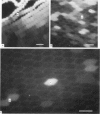Abstract
1. 42K efflux has been studied in normal and injured rat crystalline lenses to test their ability to heal over. Following injury, a sizeable, but transient, increase in fractional loss of 42K takes place. 2. The lens healing-over is Ca-dependent and cannot be accounted for by membrane resealing. This is excluded by the fact that Procion Yellow gains access to damaged fibres even 2 hr after injury (when the healing-over is completed). 3. The occlusion of the junctional channels is the basic mechanism of healing-over. This is supported by the observation that Procion Yellow does not diffuse from damaged to intact fibres and by the Ca dependency of the phenomenon.
Full text
PDF






Images in this article
Selected References
These references are in PubMed. This may not be the complete list of references from this article.
- Candia O. A. The influence of calcium-free media on the electrical properties of the isolated toad lens. Exp Eye Res. 1980 Feb;30(2):193–201. doi: 10.1016/0014-4835(80)90113-x. [DOI] [PubMed] [Google Scholar]
- Delamere N. A., Paterson C. A. The influence of calcium-free solutions upon permeability characteristics of the rabbit lens. Exp Eye Res. 1979 Jan;28(1):45–53. doi: 10.1016/0014-4835(79)90104-0. [DOI] [PubMed] [Google Scholar]
- Goodenough D. A. Lens gap junctions: a structural hypothesis for nonregulated low-resistance intercellular pathways. Invest Ophthalmol Vis Sci. 1979 Nov;18(11):1104–1122. [PubMed] [Google Scholar]
- Kistler J., Bullivant S. The connexon order in isolated lens gap junctions. J Ultrastruct Res. 1980 Jul;72(1):27–38. doi: 10.1016/s0022-5320(80)90132-x. [DOI] [PubMed] [Google Scholar]
- Loewenstein W. R. Permeable junctions. Cold Spring Harb Symp Quant Biol. 1976;40:49–63. doi: 10.1101/sqb.1976.040.01.008. [DOI] [PubMed] [Google Scholar]
- Peracchia C. Calcium effects on gap junction structure and cell coupling. Nature. 1978 Feb 16;271(5646):669–671. doi: 10.1038/271669a0. [DOI] [PubMed] [Google Scholar]
- Peracchia C., Peracchia L. L. Gap junction dynamics: reversible effects of divalent cations. J Cell Biol. 1980 Dec;87(3 Pt 1):708–718. doi: 10.1083/jcb.87.3.708. [DOI] [PMC free article] [PubMed] [Google Scholar]
- Peracchia C., Peracchia L. L. Gap junction dynamics: reversible effects of hydrogen ions. J Cell Biol. 1980 Dec;87(3 Pt 1):719–727. doi: 10.1083/jcb.87.3.719. [DOI] [PMC free article] [PubMed] [Google Scholar]
- Peracchia C. Structural correlates of gap junction permeation. Int Rev Cytol. 1980;66:81–146. doi: 10.1016/s0074-7696(08)61972-5. [DOI] [PubMed] [Google Scholar]
- ROTHSCHUH K. E. Uber den funktionellen Aufbau des Herzens aus elektrophysiologischen Elementen und über den Mechanismus der Erregungsleitung im Herzen. Pflugers Arch. 1951;253(3):238–251. doi: 10.1007/BF00363391. [DOI] [PubMed] [Google Scholar]
- Rae J. L. The movement of procion dye in the crystalline lens. Invest Ophthalmol. 1974 Feb;13(2):147–150. [PubMed] [Google Scholar]
- Riley M. V. Ion transport in damaged lenses and by isolated lens epithelium. Exp Eye Res. 1970 Jan;9(1):28–37. doi: 10.1016/s0014-4835(70)80055-0. [DOI] [PubMed] [Google Scholar]
- Spurr A. R. A low-viscosity epoxy resin embedding medium for electron microscopy. J Ultrastruct Res. 1969 Jan;26(1):31–43. doi: 10.1016/s0022-5320(69)90033-1. [DOI] [PubMed] [Google Scholar]
- WEIDMANN S. The electrical constants of Purkinje fibres. J Physiol. 1952 Nov;118(3):348–360. doi: 10.1113/jphysiol.1952.sp004799. [DOI] [PMC free article] [PubMed] [Google Scholar]



